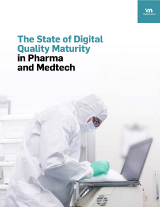
GxP Lifeline
OCM and a Digital QMS: Your Combination for a Competitive Edge

The implementation of new quality management software is an opportunity to transform your company and become a market leader. Take a Quality 4.0 approach, apply organizational change management (OCM) principles during the process, and you will achieve new levels of speed and efficiency that result in a competitive edge.
Quality 4.0 and a Digital QMS
As you select and implement an electronic quality management system (eQMS), Quality 4.0 needs to be at the forefront of your mind. For those who are unfamiliar with the term or simply need a refresher, the American Society for Quality (ASQ) provides a succinct definition of Quality 4.0:
Quality 4.0 is a term that references the future of quality and organizational excellence within the context of Industry 4.0. Quality professionals can play a vital role in leading their organizations to apply proven quality disciplines to new, digital, and disruptive technologies.
In other words, Quality 4.0 is the standard all quality leaders should try to achieve as we navigate the fourth industrial revolution. Industry 4.0 is characterized by digital transformation. To gain an advantage in the market, it’s time to embrace Industry 4.0 by leveraging advanced technologies to improve efficiency and using accurate, real-time data to inform critical business decisions.
For the era of Quality 4.0, your digital QMS must be fully connected, collect real-time data, and build quality into every stage of the product life cycle.
OCM and Implementation of a Digital QMS
OCM is often used during the implementation of digital quality management software because it helps assess, prepare, support, educate, coach, and guide employees through the people side of change. In the pursuit of Quality 4.0, you can emerge as a lighthouse company by adopting advanced technologies and leading the way for the rest of the industry. Be sure you don’t get tripped up by focusing exclusively on the technology and leaving your most valuable asset – employees – out of the equation. OCM ensures you don’t make that mistake, which could stall or permanently delay your digital transformation efforts.
Ultimately, OCM helps you to build a strong foundation for Quality 4.0:
- Your quality management software initiative will be focused on your organization’s strategic plan and led by a quality leader backed by a team united in purpose and mission.
- An understanding of how change has an impact on employees, and what they need to feel empowered by the transition to digitalization of manufacturing and other quality processes.
- A roadmap organized into multiple phases that create a clear path to accomplishing each goal in your strategic plan.
When you collaborate with and listen to your employees, it’s significantly easier to communicate how change will impact their work, and why much of it is beneficial to them as well as the company. This type of transparency, and prioritizing people first, will lead to higher adoption rates for your new digital QMS. Your organization will gain traction with Quality 4.0 initiatives, and see a rapid return on investment (ROI).
Next Steps to Transition to a Digitized QMS
To prepare for transitioning to a new digital QMS and adopting Quality 4.0 concepts, follow these suggestions, which will help you to navigate any challenges that you might encounter along the way:
- Review your strategic quality plan:
Do you have a roadmap of how the eQMS phases and activities integrate toward the strategic goals? If not, create one. The time you spend on the roadmap is a strategic investment that will lead to efficiency and success. - Explore Quality 4.0 with key stakeholders and team members:
Discuss the different elements of Quality 4.0 and prioritize which components you would like to leverage as part of your quality initiative. - Assess the impacts of organizational change on your people:
Examine your current processes, and whether they can be built on to achieve your goals for implementing a digital QMS. Understanding this will help you determine the size and impact of change as well as the educational and support requirements to help your team pivot. - Refresh or create your OCM plan:
An old saying explains that failing to plan is planning to fail. When applied to OCM, it’s important to plan while understanding that organizations don’t change, people change organizations. Your plan needs to include details about what is expected from every individual who will make the change happen.
The second part of this series will be published in May, and it will cover the steps above in greater detail. Until then, be considering what your ideal strategic quality plan looks like, and how it incorporates Quality 4.0 concepts that will help you emerge as an industry leader.
Free Resource

Enjoying this blog? Learn More.
The State of Digital Quality Maturity in Pharma and Medtech
Download Now